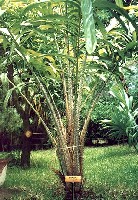View crop
View crop Data sheet EcoPortSalacca zalacca
 |
|
| Notes |
|---|
| BRIEF DESCRIPTION A relatively small, very spiny, creeping and tillering, almost stemless palm reaching 1-5 m in height, growing in compact clumps caused by successive branching at the base. Roots not extending to great depth. Leaves pinnate, 4-7 m long. Fruits exceptionally firm and crisp for a tropical fruit, globose, reddish brown, 2.5-10 x 5-8 cm. USES The ripe fruit flesh sweet and is mostly eaten fresh. The fruit may also be candied or canned and unripe fruits are used as pickles. The seeds of some forms are edible. The palms form an impregnable hedge and the very spiny leaves are also used for fences, the leaflets for thatching. The bark of the petioles may be used for matting. GROWING PERIOD Perennial. The tree starts flowering about 3-4 years after sowing. Harvesting takes place at a fruit age of 5-7 months. The palm can be productive for several decades. COMMON NAMES Salak palm, Snake fruit, Salak, Yingan, Sala, Lizard-skinned salak, Roftan-zalak. FURTHER INF Scientific synonym: S. edulis, Zalacca edulis. Salak palm occurs at elevations between sea level and 500 m in the humid tropics throughout the Malay Archipelago. Because of its superficial root system the palm requires a high water table during most of the year. Young palms require heavy shade which may be reduced after about one year. Annual yields may vary from 5-15 t/ha. | Sources |
| Westphal E 1989 pp 248-251 [USE, RAIN, DEP, DRA, LIG, TEXT, FER] Rehm S 1991 pp 234 [USE] Purseglove J 1972 pp 433 [USE, LIG, DRA, RAIN] Verheij E 1991 pp 281-284 [USE, RAIN, DRA, LIG, TEXT, FER, DEP] |